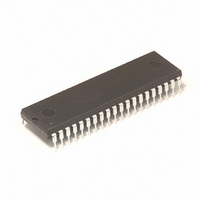MC908GP32CPE Freescale Semiconductor, MC908GP32CPE Datasheet - Page 179

MC908GP32CPE
Manufacturer Part Number
MC908GP32CPE
Description
IC MCU 8MHZ 32K FLASH 40-DIP
Manufacturer
Freescale Semiconductor
Series
HC08r
Datasheet
1.MC908GP32CFBE.pdf
(266 pages)
Specifications of MC908GP32CPE
Core Processor
HC08
Core Size
8-Bit
Speed
8MHz
Connectivity
SCI, SPI
Peripherals
LVD, POR, PWM
Number Of I /o
33
Program Memory Size
32KB (32K x 8)
Program Memory Type
FLASH
Ram Size
512 x 8
Voltage - Supply (vcc/vdd)
2.7 V ~ 5.5 V
Data Converters
A/D 8x8b
Oscillator Type
Internal
Operating Temperature
-40°C ~ 85°C
Package / Case
40-DIP (0.600", 15.24mm)
Processor Series
HC08GP
Core
HC08
Data Bus Width
8 bit
Data Ram Size
512 B
Interface Type
SCI, SPI
Maximum Clock Frequency
8 MHz
Number Of Programmable I/os
33
Number Of Timers
4
Maximum Operating Temperature
+ 85 C
Mounting Style
Through Hole
Development Tools By Supplier
FSICEBASE, DEMO908GZ60E, M68CBL05CE, M68EML08GPGTE
Minimum Operating Temperature
- 40 C
On-chip Adc
8 bit, 8 Channel
Lead Free Status / RoHS Status
Lead free / RoHS Compliant
Eeprom Size
-
Lead Free Status / Rohs Status
Details
Available stocks
Company
Part Number
Manufacturer
Quantity
Price
Company:
Part Number:
MC908GP32CPE
Manufacturer:
NXP
Quantity:
9 282
Part Number:
MC908GP32CPE
Manufacturer:
FREESCALE
Quantity:
20 000
- Current page: 179 of 266
- Download datasheet (3Mb)
15.5.2 Transmission Format When CPHA = 0
Figure 15-4
replacement for data sheet parametric information.
Two waveforms are shown for SPSCK: one for CPOL = 0 and another for CPOL = 1. The diagram may
be interpreted as a master or slave timing diagram since the serial clock (SPSCK), master in/slave out
(MISO), and master out/slave in (MOSI) pins are directly connected between the master and the slave.
The MISO signal is the output from the slave, and the MOSI signal is the output from the master. The SS
line is the slave select input to the slave. The slave SPI drives its MISO output only when its slave select
input (SS) is at logic 0, so that only the selected slave drives to the master. The SS pin of the master is
not shown but is assumed to be inactive. The SS pin of the master must be high or must be reconfigured
as general-purpose I/O not affecting the SPI. (See
SPSCK edge is the MSB capture strobe. Therefore, the slave must begin driving its data before the first
SPSCK edge, and a falling edge on the SS pin is used to start the slave data transmission. The slave’s
SS pin must be toggled back to high and then low again between each byte transmitted as shown in
Figure
When CPHA = 0 for a slave, the falling edge of SS indicates the beginning of the transmission. This
causes the SPI to leave its idle state and begin driving the MISO pin with the MSB of its data. Once the
transmission begins, no new data is allowed into the shift register from the transmit data register.
Therefore, the SPI data register of the slave must be loaded with transmit data before the falling edge of
SS. Any data written after the falling edge is stored in the transmit data register and transferred to the shift
register after the current transmission.
Freescale Semiconductor
15-5.
CAPTURE STROBE
shows an SPI transmission in which CPHA is logic 0. The figure should not be used as a
FOR REFERENCE
SPSCK; CPOL = 0
SPSCK; CPOL =1
MASTER SS
SPSCK CYCLE #
MISO/MOSI
FROM MASTER
SS; TO SLAVE
SLAVE SS
SLAVE SS
CPHA = 0
CPHA = 1
FROM SLAVE
MOSI
MISO
Figure 15-4. Transmission Format (CPHA = 0)
MSB
BYTE 1
MC68HC908GP32 Data Sheet, Rev. 10
MSB
Figure 15-5. CPHA/SS Timing
1
BIT 6
BIT 6
2
BIT 5
BIT 5
3
15.7.2 Mode Fault
BYTE 2
BIT 4
BIT 4
4
BIT 3
BIT 3
5
BIT 2
BIT 2
Error.) When CPHA = 0, the first
6
BYTE 3
BIT 1
BIT 1
7
LSB
LSB
8
Transmission Formats
179
Related parts for MC908GP32CPE
Image
Part Number
Description
Manufacturer
Datasheet
Request
R
Part Number:
Description:
Manufacturer:
Freescale Semiconductor, Inc
Datasheet:
Part Number:
Description:
Manufacturer:
Freescale Semiconductor, Inc
Datasheet:
Part Number:
Description:
Manufacturer:
Freescale Semiconductor, Inc
Datasheet:
Part Number:
Description:
Manufacturer:
Freescale Semiconductor, Inc
Datasheet:
Part Number:
Description:
Manufacturer:
Freescale Semiconductor, Inc
Datasheet:
Part Number:
Description:
Manufacturer:
Freescale Semiconductor, Inc
Datasheet:
Part Number:
Description:
Manufacturer:
Freescale Semiconductor, Inc
Datasheet:
Part Number:
Description:
Manufacturer:
Freescale Semiconductor, Inc
Datasheet:
Part Number:
Description:
Manufacturer:
Freescale Semiconductor, Inc
Datasheet:
Part Number:
Description:
Manufacturer:
Freescale Semiconductor, Inc
Datasheet:
Part Number:
Description:
Manufacturer:
Freescale Semiconductor, Inc
Datasheet:
Part Number:
Description:
Manufacturer:
Freescale Semiconductor, Inc
Datasheet:
Part Number:
Description:
Manufacturer:
Freescale Semiconductor, Inc
Datasheet:
Part Number:
Description:
Manufacturer:
Freescale Semiconductor, Inc
Datasheet:
Part Number:
Description:
Manufacturer:
Freescale Semiconductor, Inc
Datasheet:











